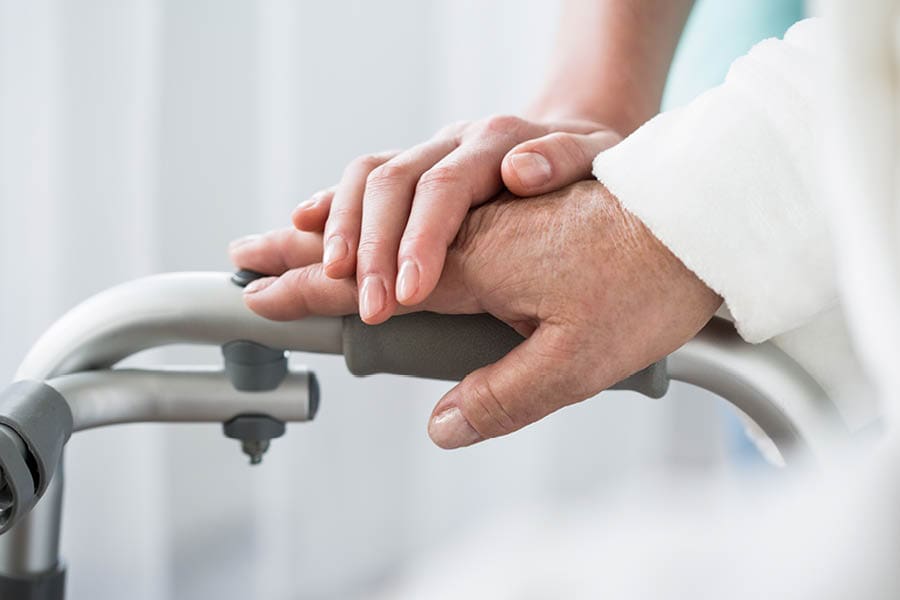
First came the rise of telehealth. Now home-based care is gaining traction as care delivery continues to move outside the four walls of the hospital and into the home and community.
“One of the things we’re seeing in the market is that every provider organization, much like they adopted virtual care technologies, is thinking about: How do I deliver care in person? How do I bring it to your living room as a preferred site of care, if it’s safe and reliable?” said Dina CEO Ashish V. Shah.
In a recent webinar: “Home as the New Care Setting: Are You Ready?,” Shah outlined four strategies to successfully navigate the shift to home-based care. He was joined by Dina Chief Medical Office Maryann Lauletta, MD, FACHE, and Tina Burbine, Vice President of Care Innovation at Healthlink Advisors. Here’s a condensed version of their conversation.
Shift in Payer Market
Ashish V. Shah: As we think about a post-Covid operating environment, it’s safe to say that the shift to care in the home that’s happened over the past few years is here to stay. Let’s start with some of the industry trends that are driving this transition to home and virtual-based care and how it ultimately impacts ACOs and other large provider organizations.

Add to this the emergence of new technologies and capabilities, a growing investment in digital health and virtual health, and, now, a consumer-driven market, with patients asking for care to be delivered in their own homes.
All of these factors have converged to create a willingness to shift authorization rules and health plan benefit design so that we can serve patients in the home. And our provider organizations are putting programs into place to adapt to that as well.
Shah: Given the context of what’s happening in the broader payer landscape, how are providers starting to think about the home as a care setting? What are some key strategies that ACOs and other provider groups can start to think through to ensure they’re positioned for success?
Maryann Lauletta: I think there are four anchors to help navigate our conversation around the shift to home-based care. The first is to create some visibility into post-acute care facility-based utilization patterns. I know everyone does this: we track and trend and monitor. But having visibility alone really isn’t enough. You need a mechanism for real-time communication so you can gain insights and create actions based on the information that you’re receiving.
Having visibility alone really isn’t enough. You need real-time communication.
Next, you need to build a preferred network of home-based providers and create visibility into that care, which can be very challenging. Many home-based providers may not be rated by CMS. They may not be owned and operated by an organization. But you need to have some influence over those providers. So how do you create that connectivity so that you can influence the care that is being provided or decisions that are being made in the home?
Driving Timely Interventions
Third, you want to establish direct connections to patients or members at home to drive timely interventions. I know many of us, for years, have been trying to do telephonic interventions for people. But we need to think beyond that because oftentimes, patients don’t respond or even pick up the phone. You end up playing phone tag, and it’s frustrating for all involved.
Beyond that, we need to think about connectivity to patients or members at home, not just in times of acute illness, but also in times of wellness or chronic disease management, so they are connected to the appropriate care at the appropriate time.

#1 Improve PAC Visibility
Shah: As you think of a high-quality network being established, as a former physician executive responsible for programs like this, what are the expectations if a member moves from acute, for example, into sub-acute or skilled nursing? What is a high-performing partner doing in terms of creating visibility and partnership?
Dr. Lauletta: It’s important to establish expectations, to have a means of communicating with the people at the SNF who are responsible for providing care. The most success I’ve ever had was when we were able to communicate electronically, in real-time, bidirectionally, where we could connect just in time when it was needed, rather than waiting for a weekly care conference to discuss our patient panel. So, the ability to have folks on the other end who are active participants, engaged, willing to exchange information, answer questions back and forth, is really key.
It’s unfair to the SNF if you don’t set up expectations, so we found ways to create care paths for the most common disease states among our patients and establish milestones and expectations for where those patients should be at different points in the journey. This helped us control the length of stay and also give some guidance to our SNF partners to our expectations in terms of recovery or the path back to wellness for our patients during their stay there.
#2 Identify High-Performing Partners
Shah: How do you go about identifying a high-quality partner? And, why does this matter if your focus is just on optimizing cost? Isn’t everything in the home just naturally going to be less expensive than what’s happening in a skilled nursing facility?
Dr. Lauletta: Quality always matters, first and foremost, both to improve outcomes and for patient satisfaction. And, let’s face it, the higher-quality providers are usually better utilizers of services and aren’t going to provide services that are not necessary. In terms of the home environment, in addition to services like home health and palliative and hospice and non-medical home care, the ability to provide in-home radiology studies or laboratory draws, those are often great satisfiers for patients, especially those with limited mobility or those who don’t have easy access to transportation or may not have great access to caregiver support.
But they can be variable. So you really do need a way to try to assess those providers based on both feedback from your members or patients as well as your own experience of care. In terms of turnaround time, when you request a service from them, how quickly are they delivering it? Are they delivering it in a satisfactory manner to that patient? Are they getting the results back to you in a timely manner? Are the reads or results appropriate? Are they actionable? Do they seem to make a difference in the care of the patient?
Many other things like medical equipment, personal care, medical supplies, home modification and meal delivery are important at different points in the patient’s journey, but most of them don’t have a ranking system. You need a way to develop your own proprietary ranking so that you can really understand who the higher-quality performers are in your geographic area.
Again, it’s the same story. Have them understand what it is you need for your patients and members. And as a follow-up, check back in with those patients to make sure that what those providers promised to deliver was actually delivered when it was supposed to.
#3 Establish a Connection to the Home
Shah: When we talk about establishing a connection with the member at home, what are provider ACOs and plan customers doing in this particular area?
Burbine: Most teams do have some sort of RPM in place, and there are a lot of different options within RPM that a team can provide to a patient. For example, remote patient monitoring kits can work well for chronically ill patients, but it’s really only a small majority of needs that are being met in that way.
And I think it’s important to recognize that RPM is not effective on its own to improve a patient’s outcome. True, effective patient monitoring needs to have the structure of a strong care team engaged daily with the patient to really understand and communicate about the variables that are impacting their health. And we’ve got to move beyond the basic vital sign information that’s part of RPM and do more than that.
Dr. Lauletta: RPM is great for objective data, but it doesn’t really give us a full picture into a patient. It doesn’t tell us if the patient has food in their refrigerator or if they can get up to get themselves a meal, if they’re toileting appropriately, if they have caregivers in the home to assist them. There’s so much more data that we need that can’t be collected through a device. So, I think that we need ways to keep in touch with the patient, not just during times of post-acute episode recovery, but throughout their chronic disease management lifecycle, and when they’re well to keep them connected to the appropriate care at the appropriate time.
RPM is great for objective data, but it doesn’t really give us a full picture into a patient.
Shah: When we’re talking about remote patient monitoring and in-home services, all of this increased visibility and tracking of what’s happening outside of a traditional health setting, very rarely will anyone push back and say that that’s not a good idea. I think what people are most concerned about is what will they do with all of that information? What if they miss something that’s critical? What do we mean by “managing by exception” and how does an ACO think about their universe expanding as care moves into the home and community?
#4 Manage By Exception
Dr. Lauletta: One of the biggest frustrations for my teams in the past, whether they were nurses or social workers, is that they spent a ton of time making phone calls and not actually reaching anyone or playing phone tag, which is dissatisfying both to the medical team member as well as the patient.
Managing by exception refers to the process of using automated check-ins to cast a broad net to interact with as many members or patients as possible, and receive feedback from them in real-time. Then you can prioritize just those responses that are the outliers, and those can be escalated to a team member to take action. And we’ve been able to show that when we are enacting automatic check-ins, 75% of our members responded and remained engaged throughout the timeline of those check-ins, which I think is pretty interesting and amazing.
And of those who are responding to our automated queries, only 3% to 7% required escalation to a team member for action.

I know that one of the biggest complaints I hear is when we feel like our time is being wasted and we’re doing activities that aren’t adding value to the patients’ lives. Every healthcare team member wants to do a good job. Every healthcare team member wants to have interactions with patients that are meaningful and produce some sort of benefit. And I feel like this is really a good way to help team members and patients to stay engaged with one another, in a way that is not burdensome.
Shah: In closing, I’d like to summarize our four key strategies. Care continues to move into post-acute care facilities, like it always has. And you need good partner networks and visibility to help you see how people are doing relative to the expected journey.
Next, care is moving into the home, so in addition to those skilled nursing facilities, you need to start thinking about all of the different home-based services that you need to organize into high-quality networks. How will you think about what’s important to your ACO in terms of measuring whether someone is actually performing like a high-quality partner? And what data are they sharing back with you, whether it’s assessment data and/or utilization data around their particular services?
That leads us to the third strategy, which is that there are going to be moments when your members are not in a skilled nursing facility or not being seen by a home-based provider, but they’re unattended, if you will. And it’s very important for you to establish a direct connection to that person in their home. For the chronically ill or the medically complex, it could be some kind of device-connected RPM kit. But there’s an opportunity, with a very lightweight model, to establish a longitudinal connection with the member on just their overall healthcare journey to drive awareness.
All of that is great, but we need to make it easy for the ACO operations team to decipher all of this information from the home and community, to be able to pluck out the needle from the haystack. So, I think the final point is making sure that the management-by-exception experience is integrated into whatever the ACO operations team has adopted to date. I think what we’re talking about is a new source of data, not necessarily a brand-new system, per se. So that integration into that care management health infrastructure is really critical.
Check out the webinar “Home as the New Care Setting: Are You Ready?,” which includes four strategies to successfully navigate the shift to home-based care.




